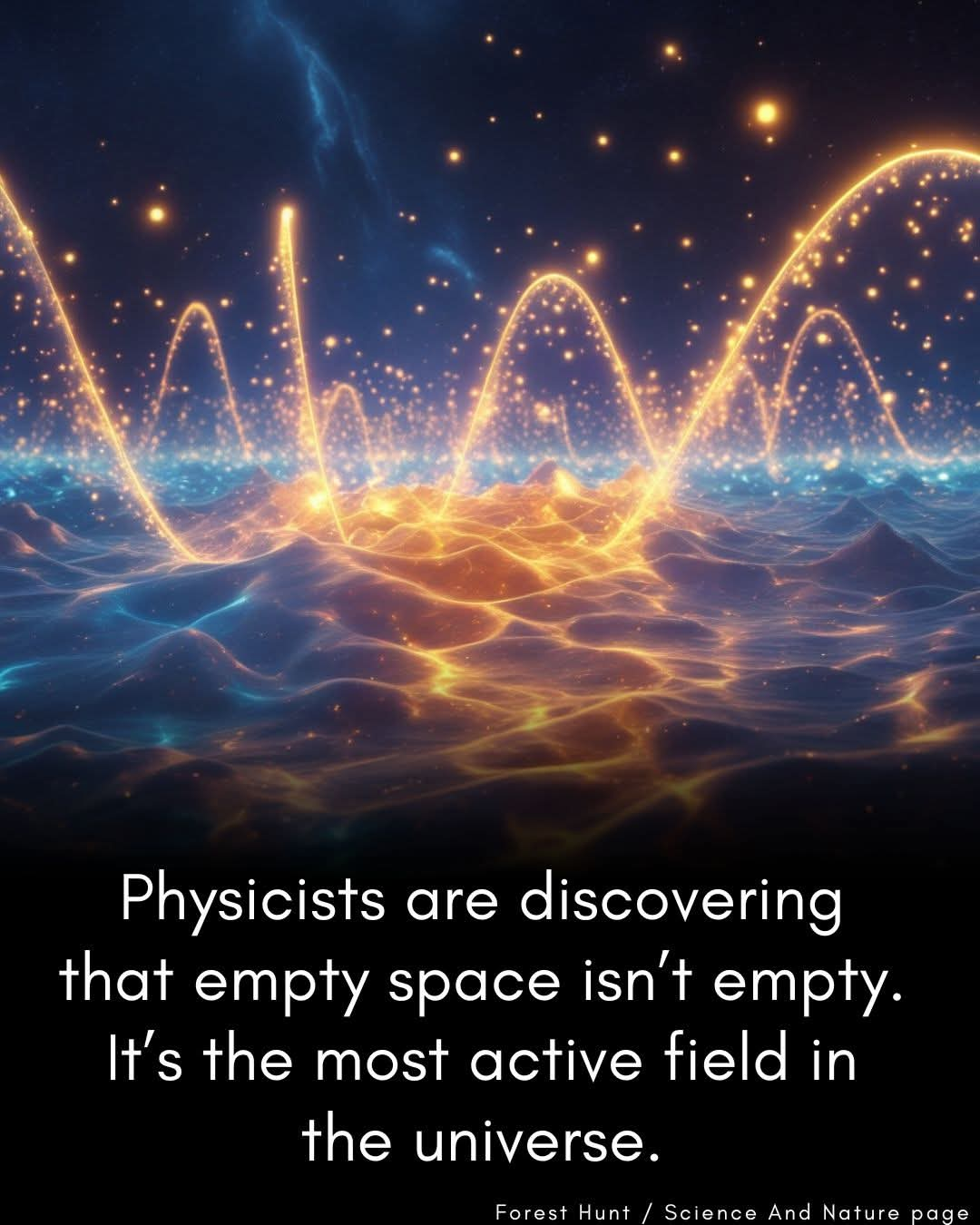At first glance, the vacuum of space appears to be the most barren and uneventful region of the universe. In popular imagination, it’s often described as a cold, empty void — a place devoid of matter and activity. However, modern physics reveals a far more complex and dynamic picture. Rather than being truly empty, the vacuum is a seething froth of invisible energy and fleeting phenomena. Among the most surprising of these is the fact that particles can seemingly "pop into existence" out of nowhere. But how can something arise from nothing? The answer lies in the strange and counterintuitive world of quantum mechanics.
The Classical View of the Vacuum
In classical physics — the framework developed by Newton and refined over centuries — a vacuum is defined as a region of space completely devoid of matter. No atoms, no radiation, not even air molecules. It is, by definition, "nothingness." Classical physics assumed that in the absence of matter and energy, space would be perfectly empty, unchanging, and passive.
This perspective began to change in the 20th century, with the advent of quantum mechanics and Einstein’s theory of relativity. These new theories reshaped our understanding of the fabric of space and time, and introduced a radically different view of what a vacuum truly is.
The Quantum Vacuum
Quantum field theory (QFT) is the most accurate framework we currently have for understanding particles and their interactions. It combines quantum mechanics with special relativity and describes all particles as excitations of underlying fields that permeate the universe. For instance, an electron is an excitation in the electron field, while a photon is an excitation in the electromagnetic field.
According to QFT, even in a perfect vacuum — with no actual particles present — these fields still exist. And crucially, due to the uncertainty principle, they can never be entirely at rest. The Heisenberg Uncertainty Principle tells us that certain pairs of properties, like energy and time, cannot both be known with perfect precision. If you try to pin down the energy in a region of space to be exactly zero, you introduce an uncertainty in the time over which that energy can remain at zero. The implication is profound: fluctuations in energy can occur spontaneously, so long as they vanish quickly enough.
These fluctuations give rise to what we call virtual particles — pairs of particles and antiparticles that briefly appear and then annihilate each other in an incredibly short timespan. They are not directly observable in the traditional sense, but their effects can be measured and have been confirmed in a variety of experiments.
Virtual Particles: Fleeting Phantoms of the Vacuum
Virtual particles are a consequence of quantum fluctuations in the vacuum. They’re called “virtual” because they don’t exist in the same way that “real” particles do — they cannot be detected directly and are not constrained by the usual laws of energy conservation, at least not within the limits allowed by the uncertainty principle.
These particle-antiparticle pairs come into existence and annihilate so quickly that they can’t be observed individually, but they do leave measurable fingerprints. One of the most famous examples is the Casimir effect, where two uncharged, closely spaced metal plates experience an attractive force due to the suppression of quantum fluctuations between them. Essentially, fewer virtual particles can exist in the narrow gap than outside it, creating a pressure difference that pushes the plates together.
Another indirect but striking confirmation comes from Hawking radiation, a theoretical prediction by Stephen Hawking in 1974. According to his theory, black holes aren’t entirely black. When virtual particle pairs form near the event horizon of a black hole, one particle may fall in while the other escapes. If the escaping particle avoids annihilation, it becomes real and carries energy away from the black hole, causing it to slowly lose mass and evaporate over time.
Zero-Point Energy: The Vacuum’s Permanent Restlessness
The restless activity of virtual particles is a manifestation of what physicists call zero-point energy — the lowest possible energy that a quantum system can have, even at absolute zero temperature. In the quantum world, there is no such thing as complete stillness. Even in its ground state, every quantum field exhibits fluctuations.
This zero-point energy is not just a mathematical curiosity; it has physical implications. For instance, the vacuum energy associated with quantum fields is thought to contribute to the cosmological constant, a term in Einstein’s equations of general relativity that affects the expansion of the universe. Observations indicate that the universe is not just expanding, but accelerating in its expansion — a phenomenon attributed to dark energy, which may well be related to vacuum energy.
However, there is a deep mystery here. The vacuum energy predicted by quantum field theory is vastly larger — by many orders of magnitude — than what is observed from the acceleration of the universe. This discrepancy, sometimes called the “vacuum catastrophe,” remains one of the greatest unsolved problems in theoretical physics.
When Virtual Becomes Real
Although virtual particles usually vanish as quickly as they appear, under certain extreme conditions they can be transformed into real particles. This process can occur when enough energy is injected into a region of space to make the fluctuations stable.
One striking example is pair production, where a high-energy photon passing near a heavy nucleus can transform into a real electron and a positron (its antiparticle). The energy of the photon is converted into the mass of the particle pair, in accordance with Einstein’s famous equation, E = mc².
Another dramatic case is vacuum decay or quantum tunneling, where a field trapped in a metastable state can suddenly transition to a more stable one, releasing energy in the form of real particles. This is a hypothetical process that could have occurred during the early universe and is sometimes invoked in theories of cosmic inflation or even in apocalyptic scenarios involving a false vacuum.
The Vacuum is Not Nothing
The takeaway from all this is clear: the quantum vacuum is anything but empty. It is a dynamic, energetic medium filled with fleeting activity and latent possibilities. Far from being the absence of everything, the vacuum is the arena in which everything happens — a vast ocean of potential from which particles can momentarily spring into being or, under the right circumstances, become permanent features of reality.
This perspective changes how we view the nature of "nothing." In the classical sense, nothingness implies the absence of space, time, matter, and energy. But in quantum physics, even the most "empty" vacuum is buzzing with activity, governed by deep and subtle laws that defy our classical intuitions.
Philosophical Implications
The phenomenon of particles appearing from the vacuum touches on age-old philosophical questions: Can something come from nothing? Is the universe itself the product of a quantum fluctuation? Some cosmologists have speculated that the Big Bang might have emerged from a quantum vacuum, a spontaneous event that gave rise to space, time, and matter as we know them. While these ideas remain speculative, they show how deeply quantum physics challenges our notions of origin and existence.
Moreover, the idea that the very structure of space is alive with activity suggests a universe that is fundamentally interconnected and dynamic, even in its most quiet and unassuming corners.
Conclusion
The idea that particles can pop into existence from a vacuum might sound like science fiction, but it is one of the most well-supported concepts in modern physics. Quantum field theory teaches us that even “empty” space is full of hidden energy and transient phenomena. These fleeting particles, though invisible and intangible under normal conditions, have real effects that shape the universe at both the microscopic and cosmic scale.
In a very real sense, the vacuum is the foundation of everything. It is not a passive void, but a vibrant quantum stage — and it reminds us that even where there appears to be nothing, the seeds of everything still lie hidden, waiting for the right conditions to come alive.
Photo Credit: Forest Hunts Science and Nature Page, linked
|
|







